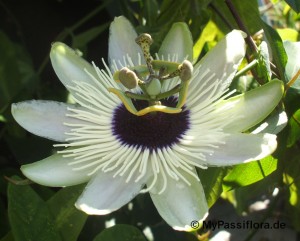Passiflora ‚Panda‘ verdankt ihren Namen ihrem Aussehen. Sie ist weiß und hat eine fast schwarze Blütenmitte, sieht also farblich einem Panda-Bären ähnlich. Genetisch ist diese Passionsblume eine komplexe Kreuzung aus Passiflora ‚Monika Fischer‘ mit der Formel (P. incarnata x P. amethystina) 4n x (P. kermesina x P. caerulea) 4n (tetraploid) und Passiflora ‚White Wedding‘ mit der Formel caerulea ´Constance Eliott` x P. eichleriana, welches ebenfalls eine tetraploide Kreuzung ist.
Passiflora ‚Panda‘ – der Chmäleon-Bär;)
Meine Passiflora ‚Panda‘-Pflanze produziert sehr unterschiedlich gefärbte Blüten. Einige weisen sogar eine stark abweichende Farbgebung auf. Interessantes Phänomen. Der Strahlenkranz hat häufig blaue Spitzen, die Blütenblätter haben gelegentlich hellblaue Farbanteile, und das Blütenzentrum, das bei dieser Passionsblumen-Sorte eigentlich fast schwarz sein sollte, fällt bei einzelnen Blüten durchaus heller und mehrfarbig aus. Vielleicht wäre Passiflora ‚Chamäleon‘ auch ein passender Name für sie gewesen;).
Das Blühverhalten meiner Passiflora ‚Panda‘ ist uneinheitlich. Sie wächst relativ zügig, ähnlich einer P. caerulea, blüht aber definitiv weniger und seltener als eine P. caerulea, wobei die Blühfreudigkeit meiner Pflanze von Jahr zu Jahr schwankt. Im Sommer 2011 hat sie ein paar mehr Blüten produziert als in den Vorjahren.
‚Passiflora Panda‘ würde ich nur Passionsblumen-Fans empfehlen, die von der kontrastreichen Farbgebung der P. ‚Panda‘ begeistert, aber auch bereit sind, auf ihren Anblick auch mal längere Zeit vergeblich zu warten;)
Passiflora ‚Panda‘ owes its name to its coloring.
The flowers are white with an almost black center. So, it looks like a Panda bear. Genetically, this Passion Flower is a complex cross between Passiflora ‚Monika Fischer‘ with the formula (P. incarnata x P. amethystina) 4n x (P. kermesina x P. caerulea) 4n (tetraploid) and Passiflora ‚White Wedding‘ with the formula caerulea ´Constance Eliott` x P. eichleriana, which is also a tetraploid hybrid.My Passiflora ‚Panda‘ plant produces very differently colored flowers. Some of them even show a coloring quite far from what it should look like. Interesting phenomenon. Maybe, Passiflora ‚Chameleon‘ would have been a good name for the plant, as well. The corona often has blue tops, the petals show a light blue coloring. The center of the flower, expected to be almost black, varies from deep purple to multi-color in individual flowers.
The blooming behaviour of my Passiflora ‚Panda‘ is not too consistent. The plant grows quite fast, similar to a Passiflora caerulea, but it flowers less often and less lasting than a P. caerulea. My plant generated some more flowers in the summer of 2011 than in the years before.
I would recomment ‚Passiflora Panda‘ only to Pasion Flower fans who are excited about the constrasty coloring of the flowers but who are also prepared to wait a longer time or even in vain for its sight;)
